technical data Seat Arona 2018 Owner's Manual
[x] Cancel search | Manufacturer: SEAT, Model Year: 2018, Model line: Arona, Model: Seat Arona 2018Pages: 316, PDF Size: 6.77 MB
Page 293 of 316
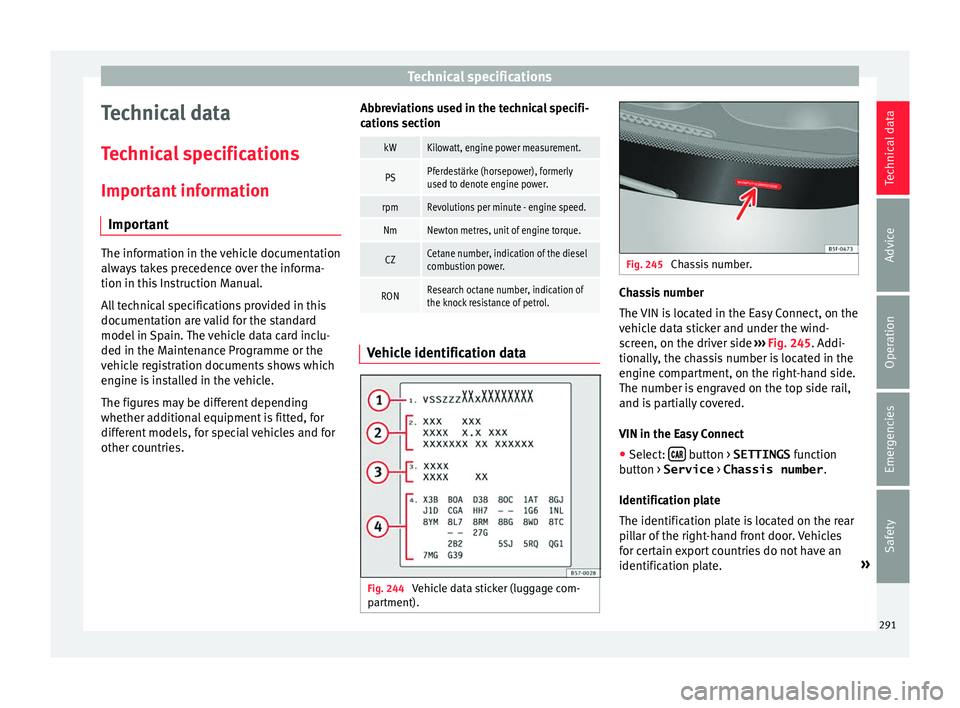
Technical specifications
Technical data
T ec
hnic
al specifications
Important information Important The information in the vehicle documentation
alwa
y
s takes precedence over the informa-
tion in this Instruction Manual.
All technical specifications provided in this
documentation are valid for the standard
model in Spain. The vehicle data card inclu-
ded in the Maintenance Programme or the
vehicle registration documents shows which
engine is installed in the vehicle.
The figures may be different depending
whether additional equipment is fitted, for
different models, for special vehicles and for
other countries. Abbreviations used in the technical specifi-
cation
s
section
kWKilowatt, engine power measurement.
PSPferdestärke (horsepower), formerly
used to denote engine power.
rpmRevolutions per minute - engine speed.
NmNewton metres, unit of engine torque.
CZCetane number, indication of the diesel
combustion power.
RONResearch octane number, indication of
the knock resistance of petrol. Vehicle identification data
Fig. 244
Vehicle data sticker (luggage com-
p ar tment). Fig. 245
Chassis number. Chassis number
The
VIN i
s
located in the Easy Connect, on the
vehicle data sticker and under the wind-
screen, on the driver side ››› Fig. 245. Addi-
tionally, the chassis number is located in the
engine compartment, on the right-hand side.
The number is engraved on the top side rail,
and is partially covered.
VIN in the Easy Connect
● Select: button > SETTINGS
fu
nction
b
utton > Service > Chassis number .
Identification plate
The identification plate is located on the rear
pillar of the right-hand front door. Vehicles
for certain export countries do not have an
identification plate. »
291
Technical data
Advice
Operation
Emergencies
Safety
Page 294 of 316
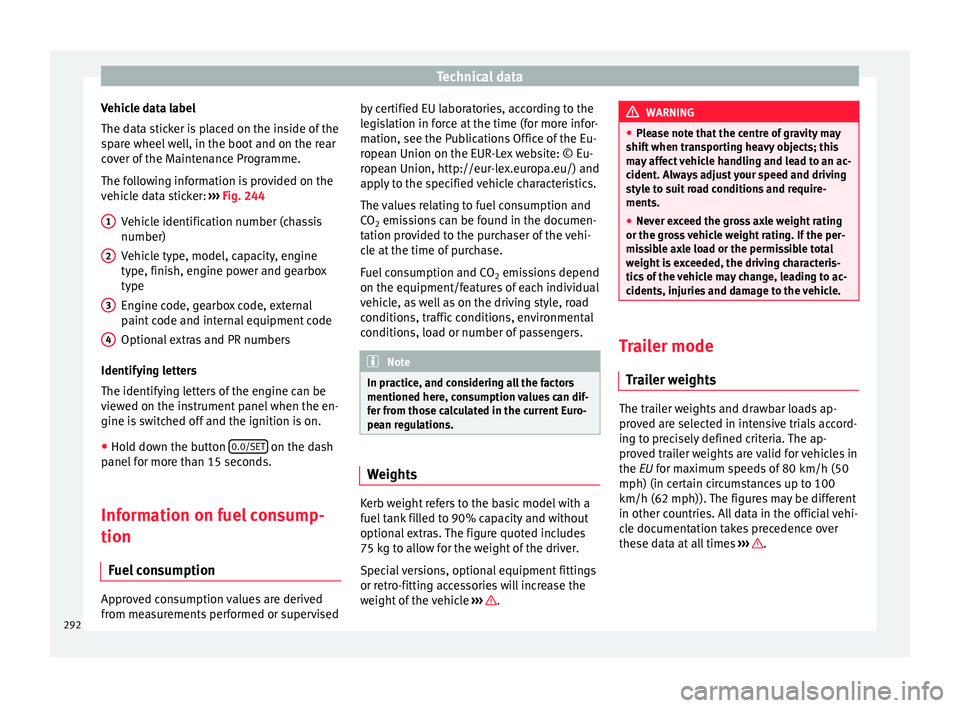
Technical data
Vehicle data label
The d at
a s
ticker is placed on the inside of the
spare wheel well, in the boot and on the rear
cover of the Maintenance Programme.
The following information is provided on the
vehicle data sticker: ››› Fig. 244
Vehicle identification number (chassis
number)
Vehicle type, model, capacity, engine
type, finish, engine power and gearbox
type
Engine code, gearbox code, external
paint code and internal equipment code
Optional extras and PR numbers
Identifying letters
The identifying letters of the engine can be
viewed on the instrument panel when the en-
gine is switched off and the ignition is on.
● Hold down the button 0.0/SET on the dash
p anel
f
or more than 15 seconds.
Information on fuel consump-
tion Fuel c
onsumption Approved consumption values are derived
fr
om me
a
surements performed or supervised
1 2
3
4 by certified EU laboratories, according to the
l
e
gi
slation in force at the time (for more infor-
mation, see the Publications Office of the Eu-
ropean Union on the EUR-Lex website: © Eu-
ropean Union, http://eur-lex.europa.eu/) and
apply to the specified vehicle characteristics.
The values relating to fuel consumption and
CO 2 emissions can be found in the documen-
tation provided to the purchaser of the vehi-
cle at the time of purchase.
Fuel consumption and CO 2 emissions depend
on the equipment/features of each individual
vehicle, as well as on the driving style, road
conditions, traffic conditions, environmental
conditions, load or number of passengers. Note
In practice, and considering all the factors
mentioned here, c on
sumption values can dif-
fer from those calculated in the current Euro-
pean regulations. Weights
Kerb weight refers to the basic model with a
f
uel
t
ank filled to 90% capacity and without
optional extras. The figure quoted includes
75 kg to allow for the weight of the driver.
Special versions, optional equipment fittings
or retro-fitting accessories will increase the
weight of the vehicle ››› . WARNING
● Ple a
se note that the centre of gravity may
shift when transporting heavy objects; this
may affect vehicle handling and lead to an ac-
cident. Always adjust your speed and driving
style to suit road conditions and require-
ments.
● Never exceed the gross axle weight rating
or the gros
s vehicle weight rating. If the per-
missible axle load or the permissible total
weight is exceeded, the driving characteris-
tics of the vehicle may change, leading to ac-
cidents, injuries and damage to the vehicle. Trailer mode
Tr
ai
ler weights The trailer weights and drawbar loads ap-
pr
o
v
ed are selected in intensive trials accord-
ing to precisely defined criteria. The ap-
proved trailer weights are valid for vehicles in
the EU for maximum speeds of 80 km/h (50
mph) (in certain circumstances up to 100
km/h (62 mph)). The figures may be different
in other countries. All data in the official vehi-
cle documentation takes precedence over
these data at all times ››› .
292
Page 295 of 316
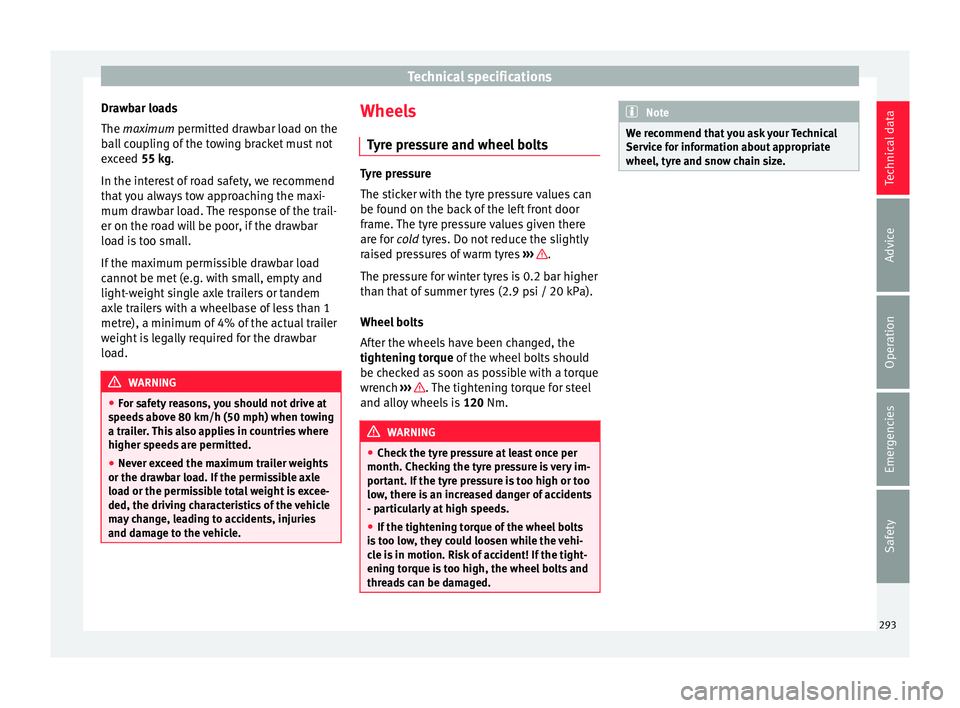
Technical specifications
Drawbar loads
The maximum permitt ed dr
a
wbar load on the
ball coupling of the towing bracket must not
exceed 55 kg.
In the interest of road safety, we recommend
that you always tow approaching the maxi-
mum drawbar load. The response of the trail-
er on the road will be poor, if the drawbar
load is too small.
If the maximum permissible drawbar load
cannot be met (e.g. with small, empty and
light-weight single axle trailers or tandem
axle trailers with a wheelbase of less than 1
metre), a minimum of 4% of the actual trailer
weight is legally required for the drawbar
load. WARNING
● For s af
ety reasons, you should not drive at
speeds above 80 km/h (50 mph) when towing
a trailer. This also applies in countries where
higher speeds are permitted.
● Never exceed the maximum trailer weights
or the drawb
ar load. If the permissible axle
load or the permissible total weight is excee-
ded, the driving characteristics of the vehicle
may change, leading to accidents, injuries
and damage to the vehicle. Wheels
Ty
r
e pressure and wheel bolts Tyre pressure
The stic
k
er with the tyre pressure values can
be found on the back of the left front door
frame. The tyre pressure values given there
are for cold tyres. Do not reduce the slightly
raised pressures of warm tyres ››› .
The pre s
sure for winter tyres is 0.2 bar higher
than that of summer tyres (2.9 psi / 20 kPa).
Wheel bolts
After the wheels have been changed, the
tightening torque of the wheel bolts should
be checked as soon as possible with a torque
wrench ››› . The tightening torque for steel
and al lo
y
wheels is 120 Nm. WARNING
● Check the ty
re pressure at least once per
month. Checking the tyre pressure is very im-
portant. If the tyre pressure is too high or too
low, there is an increased danger of accidents
- particularly at high speeds.
● If the tightening torque of the wheel bolts
is t
oo low, they could loosen while the vehi-
cle is in motion. Risk of accident! If the tight-
ening torque is too high, the wheel bolts and
threads can be damaged. Note
We recommend that you ask your Technical
Serv ic
e for information about appropriate
wheel, tyre and snow chain size. 293
Technical data
Advice
Operation
Emergencies
Safety
Page 296 of 316
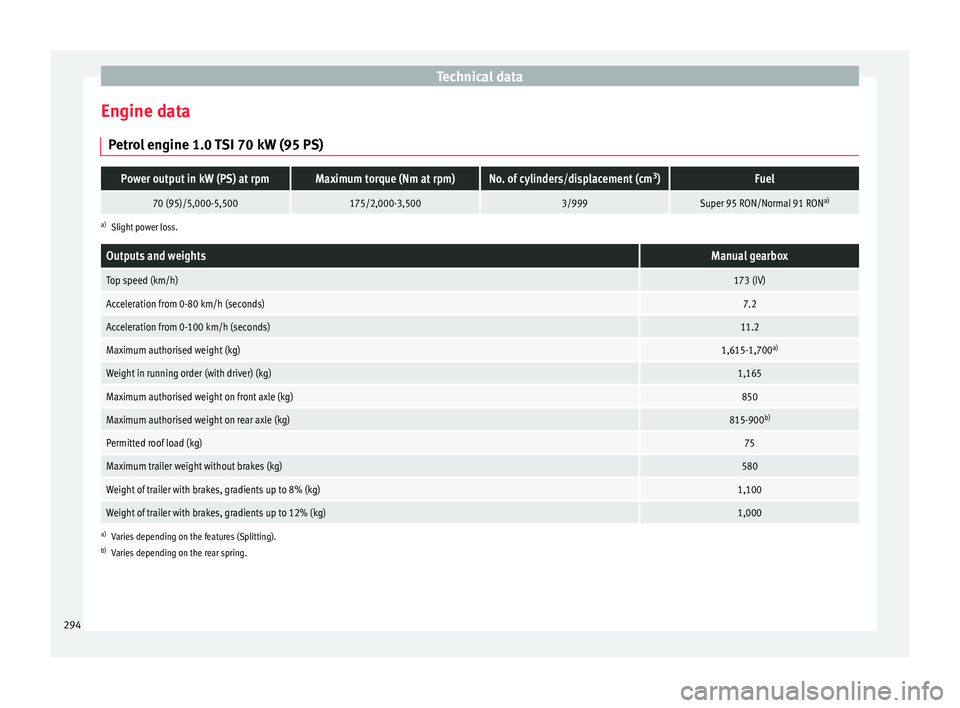
Technical data
Engine data P etr
o
l engine 1.0 TSI 70 kW (95 PS)
Power output in kW (PS) at rpmMaximum torque (Nm at rpm)No. of cylinders/displacement (cm 3
)Fuel
70 (95)/5,000-5,500175/2,000-3,5003/999Super 95 RON/Normal 91 RON a)
a)
Slight power loss.
Outputs and weightsManual gearbox
Top speed (km/h)173 (IV)
Acceleration from 0-80 km/h (seconds)7.2
Acceleration from 0-100 km/h (seconds)11.2
Maximum authorised weight (kg)1,615-1,700 a)
Weight in running order (with driver) (kg)1,165
Maximum authorised weight on front axle (kg)850
Maximum authorised weight on rear axle (kg)815-900b)
Permitted roof load (kg)75
Maximum trailer weight without brakes (kg)580
Weight of trailer with brakes, gradients up to 8% (kg)1,100
Weight of trailer with brakes, gradients up to 12% (kg)1,000
a)
Varies depending on the features (Splitting).
b) Varies depending on the rear spring. 294
Page 297 of 316
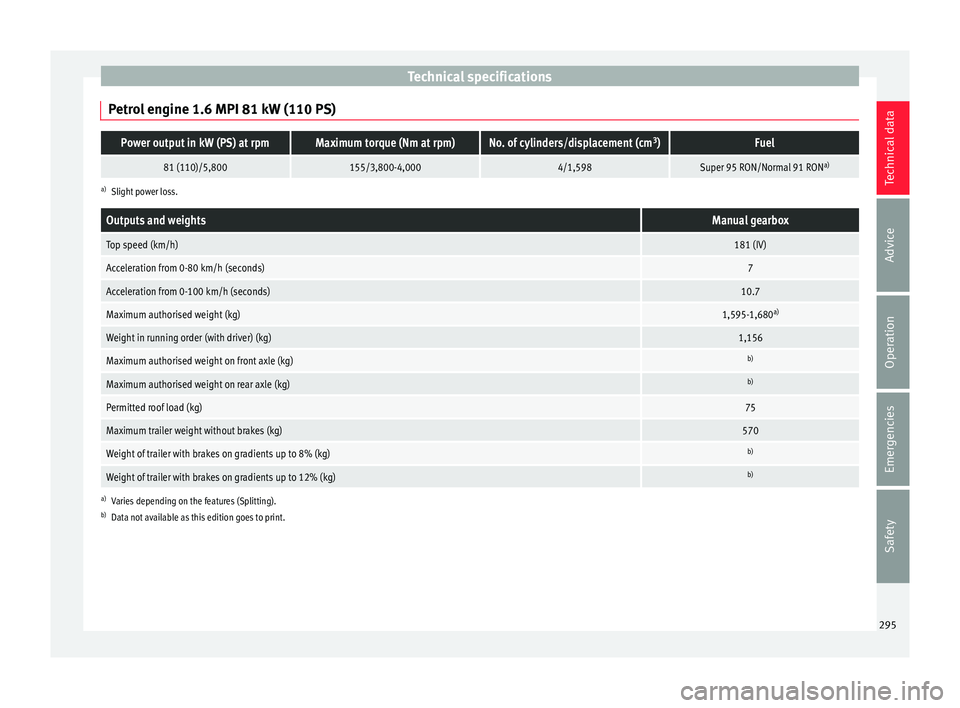
Technical specifications
Petrol engine 1.6 MPI 81 kW (110 PS)Power output in kW (PS) at rpmMaximum torque (Nm at rpm)No. of cylinders/displacement (cm 3
)Fuel
81 (110)/5,800155/3,800-4,0004/1,598Super 95 RON/Normal 91 RON a)
a)
Slight power loss.
Outputs and weightsManual gearbox
Top speed (km/h)181 (IV)
Acceleration from 0-80 km/h (seconds)7
Acceleration from 0-100 km/h (seconds)10.7
Maximum authorised weight (kg)1,595-1,680 a)
Weight in running order (with driver) (kg)1,156
Maximum authorised weight on front axle (kg)b)
Maximum authorised weight on rear axle (kg)b)
Permitted roof load (kg)75
Maximum trailer weight without brakes (kg)570
Weight of trailer with brakes on gradients up to 8% (kg)b)
Weight of trailer with brakes on gradients up to 12% (kg)b)
a)
Varies depending on the features (Splitting).
b) Data not available as this edition goes to print. 295
Technical data
Advice
Operation
Emergencies
Safety
Page 298 of 316
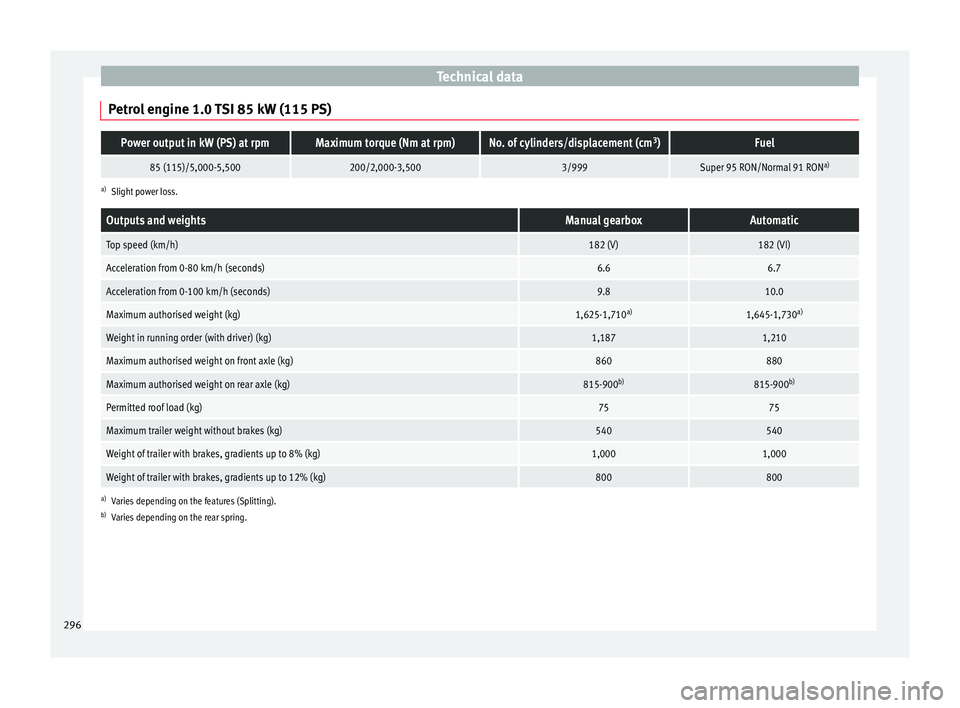
Technical data
Petrol engine 1.0 TSI 85 kW (115 PS)Power output in kW (PS) at rpmMaximum torque (Nm at rpm)No. of cylinders/displacement (cm 3
)Fuel
85 (115)/5,000-5,500200/2,000-3,5003/999Super 95 RON/Normal 91 RON a)
a)
Slight power loss.
Outputs and weightsManual gearboxAutomatic
Top speed (km/h)182 (V)182 (VI)
Acceleration from 0-80 km/h (seconds)6.66.7
Acceleration from 0-100 km/h (seconds)9.810.0
Maximum authorised weight (kg)1,625-1,710 a)1,645-1,730a)
Weight in running order (with driver) (kg)1,1871,210
Maximum authorised weight on front axle (kg)860880
Maximum authorised weight on rear axle (kg)815-900b)815-900b)
Permitted roof load (kg)7575
Maximum trailer weight without brakes (kg)540540
Weight of trailer with brakes, gradients up to 8% (kg)1,0001,000
Weight of trailer with brakes, gradients up to 12% (kg)800800
a)
Varies depending on the features (Splitting).
b) Varies depending on the rear spring. 296
Page 299 of 316
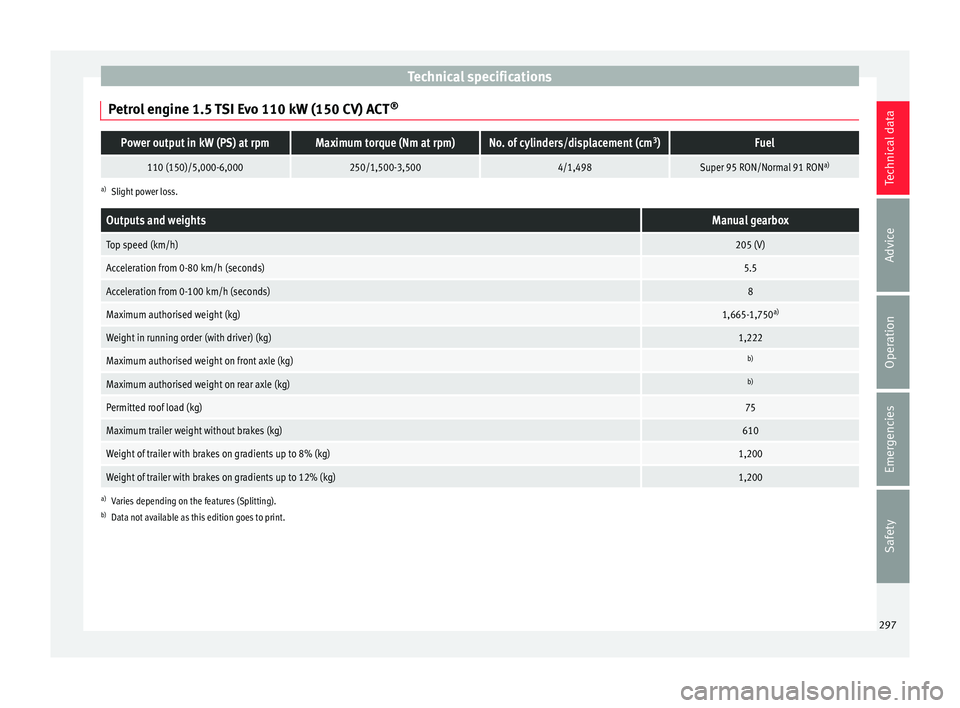
Technical specifications
Petrol engine 1.5 TSI Evo 110 kW (150 CV) ACT ®Power output in kW (PS) at rpmMaximum torque (Nm at rpm)No. of cylinders/displacement (cm
3
)Fuel
110 (150)/5,000-6,000250/1,500-3,5004/1,498Super 95 RON/Normal 91 RON a)
a)
Slight power loss.
Outputs and weightsManual gearbox
Top speed (km/h)205 (V)
Acceleration from 0-80 km/h (seconds)5.5
Acceleration from 0-100 km/h (seconds)8
Maximum authorised weight (kg)1,665-1,750 a)
Weight in running order (with driver) (kg)1,222
Maximum authorised weight on front axle (kg)b)
Maximum authorised weight on rear axle (kg)b)
Permitted roof load (kg)75
Maximum trailer weight without brakes (kg)610
Weight of trailer with brakes on gradients up to 8% (kg)1,200
Weight of trailer with brakes on gradients up to 12% (kg)1,200
a)
Varies depending on the features (Splitting).
b) Data not available as this edition goes to print. 297
Technical data
Advice
Operation
Emergencies
Safety
Page 300 of 316
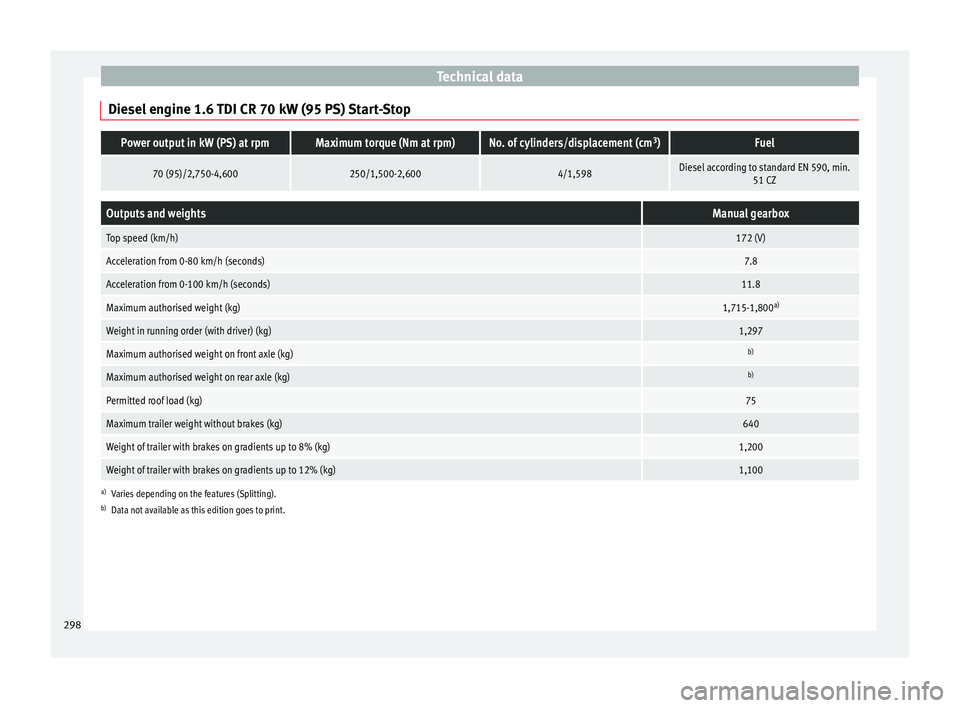
Technical data
Diesel engine 1.6 TDI CR 70 kW (95 PS) Start-StopPower output in kW (PS) at rpmMaximum torque (Nm at rpm)No. of cylinders/displacement (cm 3
)Fuel
70 (95)/2,750-4,600250/1,500-2,6004/1,598Diesel according to standard EN 590, min.
51 CZ
Outputs and weightsManual gearbox
Top speed (km/h)172 (V)
Acceleration from 0-80 km/h (seconds)7.8
Acceleration from 0-100 km/h (seconds)11.8
Maximum authorised weight (kg)1,715-1,800a)
Weight in running order (with driver) (kg)1,297
Maximum authorised weight on front axle (kg)b)
Maximum authorised weight on rear axle (kg)b)
Permitted roof load (kg)75
Maximum trailer weight without brakes (kg)640
Weight of trailer with brakes on gradients up to 8% (kg)1,200
Weight of trailer with brakes on gradients up to 12% (kg)1,100
a)
Varies depending on the features (Splitting).
b) Data not available as this edition goes to print. 298
Page 301 of 316
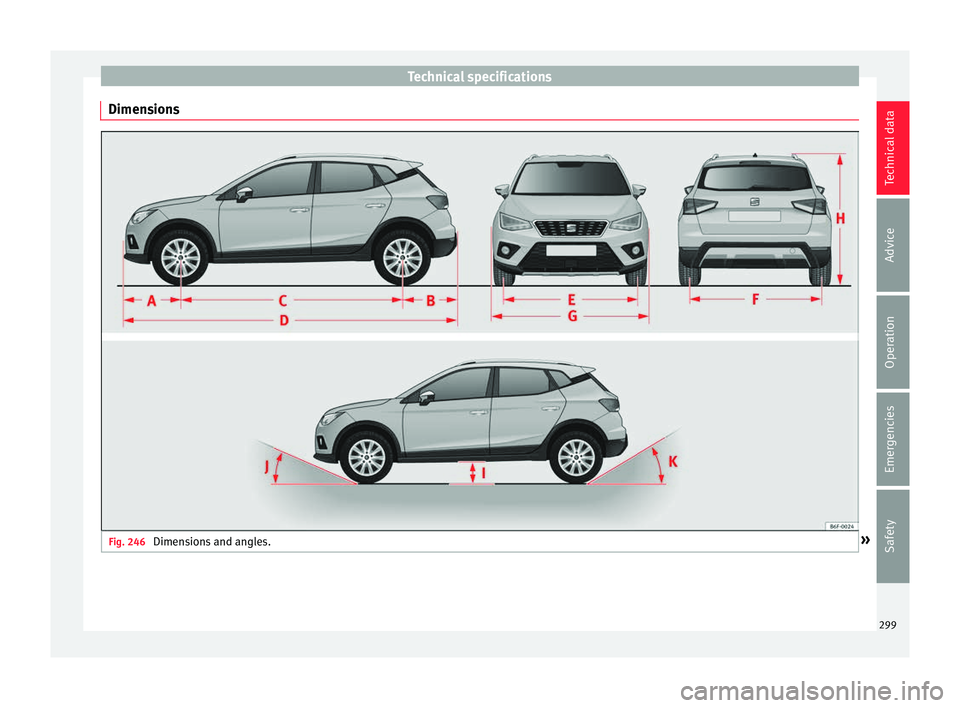
Technical specifications
Dimensions Fig. 246
Dimensions and angles. » 299Technical data
Advice
Operation
Emergencies
Safety
Page 302 of 316
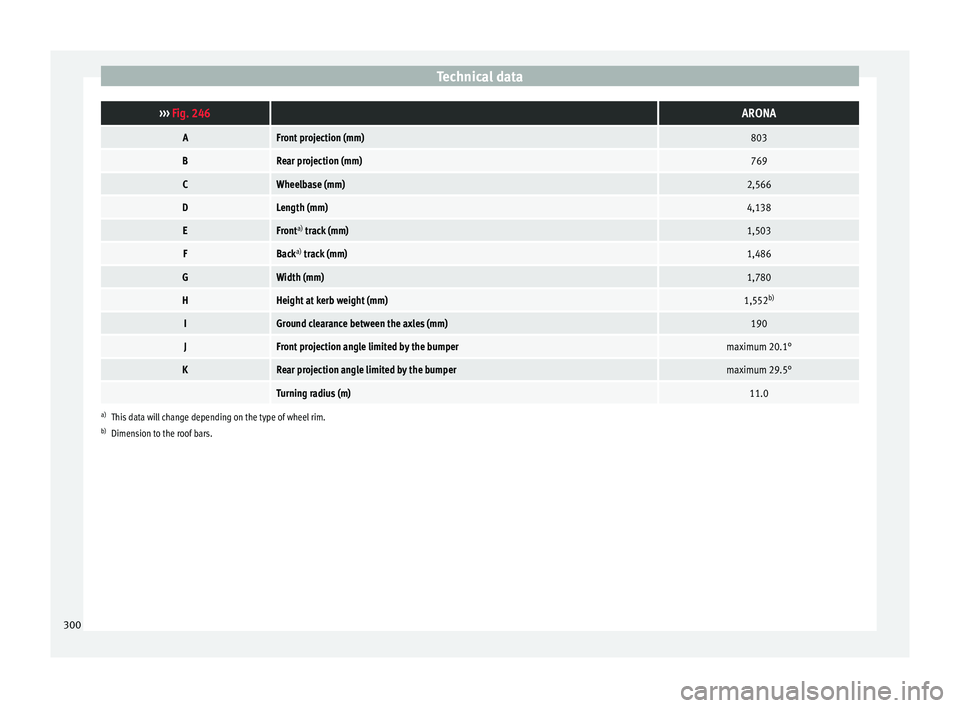
Technical data›››
Fig. 246 ARONA
AFront projection (mm)803
BRear projection (mm)769
CWheelbase (mm)2,566
DLength (mm)4,138
EFront a)
track (mm)1,503
FBack a)
track (mm)1,486
GWidth (mm)1,780
HHeight at kerb weight (mm)1,552 b)
IGround clearance between the axles (mm)190
JFront projection angle limited by the bumpermaximum 20.1°
KRear projection angle limited by the bumpermaximum 29.5°
Turning radius (m)11.0
a)
This data will change depending on the type of wheel rim.
b) Dimension to the roof bars.
300